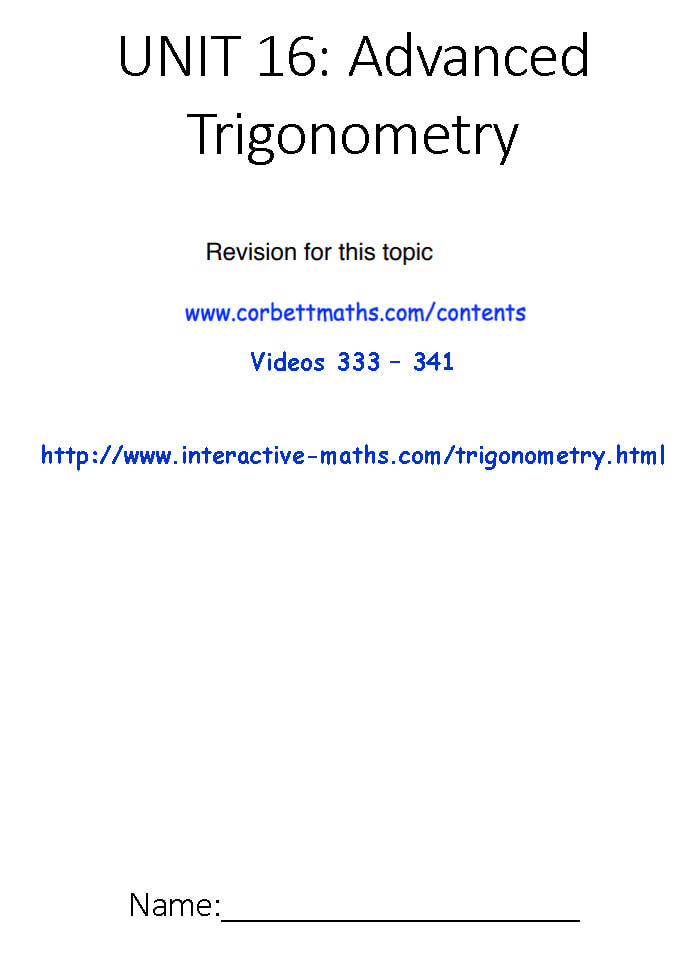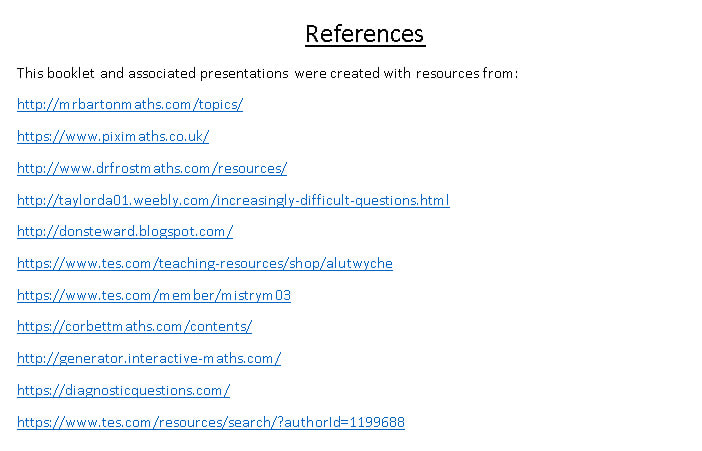- Right Angled Trigonometry (recap of prior knowledge)
- Angles bigger than 90 (includes labelling triangles and calculator skills)
- Sine Rule (split into lengths then angles)
- Cosine Rule (split into lengths then angles)
- Area of a Triangle (finding area then finding other missing information)
- Choosing the Rule
- Bearings
- Trigonometric Graphs
- Exact Values (the standard results)
- Other Exact Values (given value of sin x find cos x)
The skill starts with a short item on the required prior knowledge for that particular skill. Sometimes this is a recap of a prior skill from the current unit (eg factorising quadratics before solving them). Sometimes it is something from an earlier unit (eg solving equations before sine rule).
Next there is a section for notes. In terms of teaching, this is when I will explain the new skill, and give any definitions, etc.
The notes section is followed by sets of Example Problem Pairs. These largely follow the idea set out by Craig Barton here, though I have not been so careful with making them minimally different yet. Perhaps I will adjust these moving forward.
After the example problem pairs, there will be an exercise. This will probably be a fairly classic set of questions to practice the new skill they have just learned. I do sometimes make use of the sets of questions from Variation Theory, but also use CorbettMaths, Dr Frost Maths, 10 Ticks, exercises from our ebooks, Pixi Maths and my own site Interactive Maths. These are not the only ones I use, as I also get stuff from TES and Resourceaholic, and have found the old textbooks great for some of these too.
Sometimes I will also include links to even further practice for students. Usually this is to a page in their textbook or CorbettMaths, but also CIMT. We very rarely use these in class, and they are provided as extra for students to do in their revision outside of class.
These are not always included in the skill, but when they are I use them as a quick way to check before moving on to another subskill, or before more independent practice. These will usually be answered on mini-whiteboards, and are there in case students struggled with the your turn and need a little more guided practice before moving on to the exercise. They normally include 4 questions similar in style to the example problem pair.
Sometimes a skill is broken into smaller sub-skills. Rather than creating booklets with 20 skills for a unit (which I feel can be a bit overwhelming) I will not relabel these sub-skills, but rather incorporate them into the bigger skill. For example, in the skill of Sine Rule, there is a section on finding lengths and then on finding angles.
I sometimes include activities like matching activities, or odd one outs. These will often cover the whole skill and so will be included at the end of the skill. Sometimes this is just a blank space with a title to stick in the cards. Other times there is more structure. It depends on the activity. This is where I still get to include some of the great activities you find on TES.
At the end of the skill there is usually a challenge section. What I mean by challenge is that it is not your "ordinary" style questions. This is where I include things like Maths Venns, stuff from Don Steward, Clumsy Clives, Arithmagons, stuff from nrich, UKMT questions. This is not something I included from the beginning so not all booklets have them yet, but I will be adding as I find new things and adapt them the next time I teach the unit.
At the end of the booklet I like to include a unit review section. This will always include a Unit Review Worksheet which basically has a two questions on each of the sub-skills from the unit. It is meant to be used by students to assess themselves on what they can and cannot do.
For some units I also included a section of exam questions on the topic at the end of the booklet. We already have a set of documents of exam questions by topic, so this is not something I have done religiously as they already existed. However, I am starting to think that including them at the end would remind me to make use of them more often, and would truly enable students to have everything in one place.
In part 1 I discussed 10 reasons why I have been won over by the use of booklets. Some of these are determined by the way I make the booklets (e.g. having everything in one place). Although there is definitely an initial time commitment to putting these booklets together in the first place, in following years you only have minor tinkering to do for a whole unit, which allows you to focus on how you can best use the booklet in your teaching, and how you can use that extra time made available to teach better. In part 3 of this series I will be exploring how I go about using the booklets I produce, both in planning and in class.


 RSS Feed
RSS Feed
